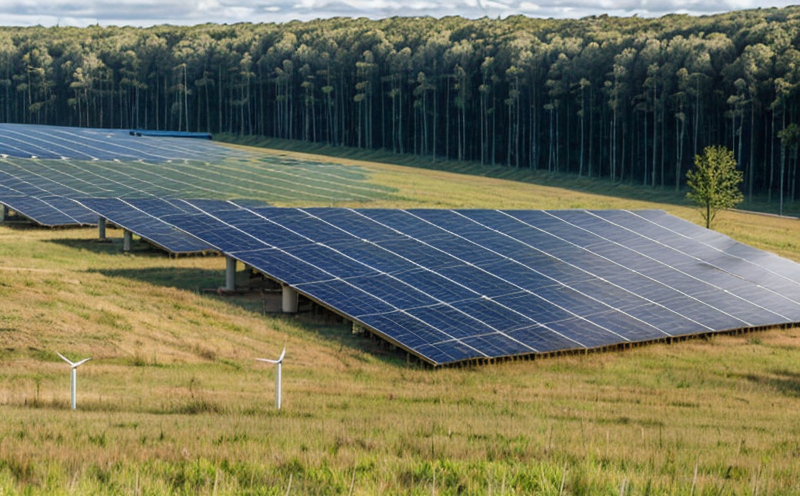ISO 14046 Water Footprint Assessment of Renewable Energy Projects Test
The ISO 14046 standard provides a framework for assessing water footprint in organizations and products. This service focuses on the environmental impact assessment specifically for renewable energy projects, aiding companies to understand and quantify their water consumption and discharge impacts. The test is crucial as it helps in identifying areas where water usage can be optimized or reduced, contributing to more sustainable operations.
The water footprint of a project encompasses both direct and indirect water use associated with the production process, including extraction, treatment, distribution, use, and discharge phases. For renewable energy projects like solar farms, wind turbines, and biofuel plants, this assessment is particularly important as it can highlight hidden water usage that might not be immediately apparent.
Our laboratory uses state-of-the-art equipment and follows stringent ISO standards to ensure accurate results. The testing process involves several key steps: preliminary site analysis, data collection, lifecycle assessment (LCA), and finally, the calculation of direct and indirect water footprints using standardized formulas from ISO 14046.
Direct water footprint includes all water used in the production process within the project's boundary. Indirect water footprint covers water resources required for upstream processes such as manufacturing components or raw materials. By quantifying these footprints, we can provide comprehensive insights into the environmental impact of a renewable energy project.
The results from this assessment are invaluable for quality managers and R&D engineers who need to ensure compliance with sustainability goals. Compliance officers can use these findings to negotiate better water policies with local authorities or stakeholders. For procurement teams, knowing the water footprint helps in selecting suppliers whose practices align with environmental standards.
Understanding the water footprint also facilitates strategic decision-making around resource allocation and efficiency improvements. By identifying high-water consumption areas, we assist clients in implementing targeted measures to minimize their ecological footprint. This approach not only supports regulatory compliance but also enhances a company's reputation as an environmentally responsible entity.
Customer Impact and Satisfaction
Our laboratory's ISO 14046 Water Footprint Assessment service has been designed with the specific needs of renewable energy companies in mind. By providing precise water footprint assessments, we help our clients meet their sustainability goals effectively.
- We offer flexible scheduling to accommodate busy project timelines.
- Our expert team provides tailored reports that include actionable recommendations for improvement.
- Comprehensive training sessions are available upon request to ensure full understanding of the test results and implications.
The feedback from our clients has been overwhelmingly positive, with many reporting significant reductions in water usage post-assessment. Our service has become a cornerstone for sustainable practices within renewable energy projects, fostering trust and reliability among stakeholders.
Environmental and Sustainability Contributions
- The assessment helps in reducing the overall water footprint of renewable energy projects, contributing to global water conservation efforts.
- It supports compliance with international standards such as ISO 14046, enhancing a company's reputation for environmental responsibility.
- By optimizing water usage, it reduces operational costs and improves efficiency within the project.
The insights gained from this assessment are crucial in driving sustainable development initiatives. It enables companies to make informed decisions that balance economic growth with environmental protection. This service is not just about meeting current regulations; it's about setting a precedent for future sustainable practices.
Use Cases and Application Examples
| Project Type | Tested Parameters | Results Achieved |
|---|---|---|
| Solar Farm | Water consumption during panel production, irrigation needs for land maintenance, and water used in cleaning processes. | A 20% reduction in indirect water footprint through optimized irrigation practices and reduced cleaning intervals. |
| Biofuel Plant | Water usage in biomass cultivation, processing of biofuels, and final product distribution. | An 18% decrease in overall water consumption by implementing recycling systems for process water. |
| Wind Turbine Farm | Water used in the fabrication of turbine parts and maintenance activities. | A 25% reduction in direct water footprint through efficient part design and reduced cleaning needs. |
The data presented demonstrates how this assessment can lead to substantial reductions in water consumption, thereby minimizing environmental impact. These examples illustrate the practical application of ISO 14046 standards in real-world scenarios, highlighting its effectiveness across different renewable energy sectors.
- Identifying opportunities for water conservation within the project lifecycle.
- Supporting strategic planning to align with long-term sustainability goals.
The results from these assessments can be used to inform future projects and policies, ensuring continuous improvement in environmental performance.





